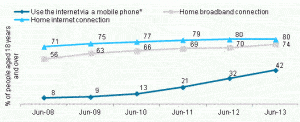The Internet in Australia 1994-2014
Though the internet has been around for much longer, 1994 was when it truly kicked off, commercially at least, here in Australia.
In 1994, internet usage in Australia was around 2% of the population, mostly from those involved with academia. In 1995, AARnet, the organisation that ran the Australian internet, decided that the restrictions for commercial and private use should be lifted and handed Telstra the keys to the castle.
Within 3 years, usage rose a further 5% and as the technology began to gain a foothold it leapt to an enormous 54% by 2002. Since then it has risen steadily and now stands at around 90%.
Early on, access was ordinarily via a PC and dial up modem. Sophistication was low and download speeds archaic, certainly compared to today at least. Many flippantly referred to the Net as a fad and although you could buy big ticket items you couldn’t buy a small value item like a newspaper so how could it replace or indeed threaten the existence of a real shop. There were some payment gateways around such as Camtech and BPay (IBT itself developed an online credit card payment system for the Australian Civil Aviation Safety Authority in 1999) but they were in their infancy.
Although growth in connectivity terms was sharpest in the first 9 years of its existence, the dollar value transacted between 2002 and 2012 reflects the real evolution of the internet as we know it today.
In less than a decade, we have gone from one stationary device with no apparent commercial value to several devices (mobile and stationary) and every payment system under the sun. Did we all see this coming? Did we know that in just a few short years we would have complete trust in the way we buy things online? Could we foresee that we would buy clothes and even footwear without trying them on? I didn’t and yet I do now.
“Usage is up, choices and platforms are growing, mobility is all-consuming and our online experience is getting deeper and more intense, as we do more and more activities via the internet.”
ACMA chairman, Chris Chapman
Is it likely to stop there and about to peak? Can we expect a consolidation of devices?
“If every TV in Australia had interactive connection what will that do to the traffic?”
Chris Lomax, Integrated Business Technologies (IBT)
Predicting internet trends and new technologies has proven to be difficult in the past and although we are getting better at it the medium is still an emerging technology and will continue to catch us out.
“Despite the extraordinarily rapid rate of change, Australians seem to be adapting reasonably confidently and relatively seamlessly to an Internet-enabled world,”
ACMA chairman, Chris Chapman said in a statement.
20 years have flown by and the internet is now as familiar to us today as the electric telephone was to our parents. Surely then we should be able to have a stab at some of the future trends by now?
Let’s look at one forecast from back then. Traditional post offices around the world and other ‘snail mail’ based organisations would disappear as email and other digital communication would render them obsolete. Far from becoming out-dated, post offices have grown considerably as have other parcel based organisations. In hindsight that makes sense but it wasn’t that clear at the time.
So, demand for information and services continues to increase and at a rate that will be difficult to adequately deliver to or predict. The impact of this will be widespread and will seep into every aspect of our lives. That will make the jobs of those who have to deliver to the ever growing aspirations of its customers much harder.
iTV (interactive TV) was always going to be the next great event so how will that effect the demand put on organisations? If over 40% of the population access the internet via a mobile device and 80% via Home internet PCs etc., should we expect traffic to increase exponentially? Could we be facing potentially 3 times the traffic over the next few years?
Our guess is that with connections nearing saturation point, organisations will turn their attention to time spent on the net and the sophistication of a user/consumer/customer’s experience.
In 2012 for instance, the average time spent on the web during a week was almost 22 hours, eclipsing TV, and growing to over 26 hours for those aged between 16 and 24. Men prefer connecting via PC’s and women prefer mobile phones whilst simultaneously watching TV or listening to the radio. The younger generation use tablets or laptops, whilst texting on their mobiles.
And that was over a year ago. It will be even longer today.
These same users felt that there should be more development in useful mobile apps for 6 key industry sectors: Government Services, Transport, Medical related, Banking/Finance, Maps & Weather. The oldest Gen Xer’s are staring at some sort of retirement and will be keen to see more online health systems. The Gen Y’s will be looking at universities and schools to provide more and more information and facilities.
“consumers draw on a variety of sources … to support their decision making: 71% read other(s) opinions. 59% watch online videos …”
Neilsen Report 2012
60% of users liked to interact with rich media, such as sites that use streaming video for instance, or cursors that changed when hovered over a subject. A similar number used the “like” and “share” button features on sites. And 70% followed other users’ opinions. So perhaps this is what needs to be developed; easier and more intuitive ways for organisations to get its products and services reviewed and liked, and ultimately bought or chosen.
What we can predict is that…it is difficult to predict anything. History tells us that.
I will end with the wisdom of Barry Leiner, Vinton Cerf and David Clark who wrote “A Brief History of the Internet” back in 1998:
… the architecture of the Internet has always been driven by a core group of designers, but the form of that group has changed as the number of interested parties has grown. With the success of the Internet has come a proliferation of stakeholders – stakeholders now with an economic as well as an intellectual investment in the network.
At the same time, the industry struggles to find the economic rationale for the large investment needed for the future growth, for example to upgrade residential access to a more suitable technology. If the Internet stumbles, it will not be because we lack for technology, vision, or motivation. It will be because we cannot set a direction and march collectively into the future.
Food for thought:
Do you remember any other internet predictions that didn’t quite work out?
Will there be mass take-up of Interactive TV?
If so, how will the increased traffic demand affect your organisation?
Have you factored potential traffic increases from mobile devices and iTV into your plans?
What strategies and tools are needed to cope with future information and services demand from the internet?



